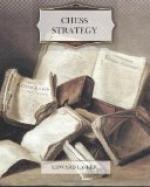If a King is unable to move, though not attacked, and none of his remaining pieces can move, the King is said to be stale-mated, and the game is drawn. A game is also drawn when neither side has sufficient material left to enforce a mate. (Compare page 63.)
If a player resigns his game before he is actually mated, he acknowledges that in the end mate is unavoidable, and the game is counted as a loss to him.
A game is null and void if it is shown that a mistake was made in setting the board or men. The same applies when in the course of the game the position and number of pieces have been altered in a manner not in accordance with the proper course of play, and the latter cannot be re-constructed from the point where the error was made.
If a player having the move touches one of his pieces he is under compulsion to move it; if he touches a hostile piece he must capture it, provided that the piece can be properly moved or captured in either case. This rule is of no effect if the piece so touched cannot be moved or captured, as the case may be. So long as the hand has not left the piece to be moved, the latter can be placed on any accessible square. If a player touches a piece with the sole object of adjusting its position, he must apprise his opponent of his intention by saying “J’adoube” beforehand. It is best to move the King first when castling. If the Rook is moved first, and unless the King is played almost simultaneously, a doubt might arise whether castling or a Rook’s move only was intended.
If a player has castled illegally, Rook and King must be moved back, and the King must make another move, if there is a legal one. If not, any other move can be played. A player who makes an illegal move with a piece must retract that move, and make another one if possible with the same piece. If the mistake is only noticed later on, the game should be restarted from the position in which the error occurred.
II. NOTATION
A special notation has been adopted to make the study of games and positions possible, and it is necessary for students of the game to become thoroughly conversant with it. The original and earliest notation is still in use in English, French, and Spanish speaking countries. It is derived from the original position in the game, in that the squares take the names of the pieces which occupy them. Thus the corner squares are called R 1 (Rook’s square or Rook’s first), and to distinguish them from one another QR1 or KR 1 (Queen’s or King’s Rook’s square). The squares immediately in front are called QR2 or KR2. A distinction is made between White and Black, and White’s R 1 is Black’s R 8, Black’s R 2 is White’s R 7, White’s K B 3 is Black’s KB6, and so on. K stands for King; Q for Queen; B for Bishop; Kt for Knight; R for Rook; and P for Pawn. In describing a capture, only the capturing and the captured pieces are mentioned, and not the squares.




